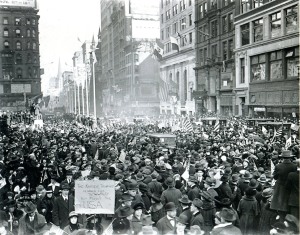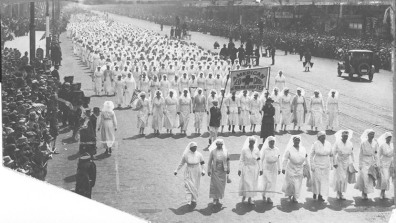.
“Feisty” Newark, NJ Mayor Charles P. Gillen refused to close his city’s saloons completely during 1918 epidemic as per State of New Jersey’s orders:
 Image: “Newark Mayor Charles P. Gillen. The feisty mayor refused to close his city’s saloons completely during the epidemic, as per the state’s orders.” image, “New York, New York, American Influenza Epidemic 1918-1919,” InfluenzaArchive.org
Image: “Newark Mayor Charles P. Gillen. The feisty mayor refused to close his city’s saloons completely during the epidemic, as per the state’s orders.” image, “New York, New York, American Influenza Epidemic 1918-1919,” InfluenzaArchive.org
……………………
Added:
May 19, 2020, “Spanish Flu,” [H1N1 bird flu] History.com Editors
“During the flu pandemic of 1918, the New York City health commissioner tried to slow the transmission of the [H1N1 Bird] flu by ordering businesses to open and close on staggered shifts to avoid overcrowding on the subways....Complicating matters was the fact that World War I had left parts of America with a shortage of physicians and other health workers. And of the available medical personnel in the U.S., many came down with the flu themselves.” [subhead, “Fighting the Spanish flu"]
………………………………
Added: “New York, New York, American [H1N1 Bird] Influenza Epidemic 1918-1919,” Influenza Encyclopedia, InfluenzaArchive.org
 [Image: “Throngs of New Yorkers fill the streets of Manhattan to celebrate Armistice Day, November 11, 1918. The National Archives and Records Administration”]
[Image: “Throngs of New Yorkers fill the streets of Manhattan to celebrate Armistice Day, November 11, 1918. The National Archives and Records Administration”]
“When the Norwegian vessel Bergensfjord steamed into New York City’s harbor on August 11, 1918, an unusual welcoming committee awaited on shore. The ship held 11 crew and ten passengers infected with a new and particularly aggressive form of influenza. On the pier were ambulances and health officer for the Port of New York, who immediately whisked the ill sailors to a city hospital. Sailors who had become ill during the voyage but were now recovering as well as those in contact with the sick while on board where put under close surveillance by New York City Department of Health nurses.1 New York – no stranger to epidemics – had a long-standing tradition of disease surveillance, isolation, and quarantine, and it was this mechanism that went into immediate effect.
Over the course of the next several weeks, more ships bearing ill sailors arrived at New York harbor. On August 16, the Nieuw Amsterdam arrived in New York from Rotterdam, with 22 passengers aboard sick with influenza. On September 4, a French liner Rochambeau arrived with 22 new cases of influenza on board; two victims had already died at sea. The city’s health department placed all the ill men in isolation at the Willard Parker Hospital on East 16th Street and at the French Hospital on W. 34th Street.2 In an attempt to lessen the likelihood of influenza spreading to New York’s population, health commissioner Dr. Royal S. Copeland placed the entire Port of New York under quarantine on September 12."…
[Image: “New Yorkers gather in the streets to celebrate Armistice Day, November 11, 1918. Public health officers across the nation feared that such large-scale gatherings would help continue to spread influenza, but knew that there was little they could do to try and stop them. The National Archives and Records Administration"]
……………………
Added: Newark, New Jersey chapter of American Red Cross marches to celebrate end of World War I:
“The Newark [NJ] chapter of the American Red Cross marching to celebrate the end of World War I. The Newark Public Library”
…………………………………………….
Added: “1918 Pandemic (H1N1 virus) [Bird flu],” cdc.gov
“The 1918 influenza pandemic…was caused by an H1N1 virus with genes of avian origin. Although there is not universal consensus regarding where the virus originated, it spread worldwide during 1918-1919. In the United States, it was first identified in military personnel in spring 1918….
Mortality was high in people younger than 5 years old, 20-40 years old, and 65 years and older. The high mortality in healthy people, including those in the 20-40 year age group, was a unique feature of this pandemic.”…"Complicating matters was the fact that World War I had left parts of America with a shortage of physicians and other health workers. And of the available medical personnel in the U.S., many came down with the flu themselves.” [subhead, “Fighting the Spanish flu"]
..................


No comments:
Post a Comment